
Cook Islands’ Only Travel Guide You Need For A Great Trip in 11 Easy Steps
- Destinations Oceania
Cruisit Team
- July 20, 2022
- 0
- 4815
- 67 minutes read
Cook Islands’ Background
Polynesian people who moved from Tahiti, an island northeast of Rarotonga, are estimated to have originally arrived in the Cook Islands around AD 1000. Polynesians, mostly from what is now French Polynesia, were the only occupants of the Cook Islands until the nineteenth century. Each island was independent, with very minor exceptions, and each of the bigger islands had many rival ethnic populations. In the late 1500s and early 1600s, Spanish explorers visited many islands in the northern group but did not stay.
In 1773, 1774, and 1777, Capt. James Cook was the first European to visit most of the islands in the southern group. Excluding the isolated Pukapuka residents, who are mostly Samoan and Tongan, practically all Cook Islanders have mixed Polynesian origin. In the early nineteenth century, intermarriage between European, Chinese, and African settlers was prevalent.
Originally known as the Hervey Isles after a British lord, the Russians renamed them the Cook Islands in 1823 to honor the famed commander, Captain James Cook. Fearing a French takeover, as had occurred in adjacent Tahiti and several of the other Society Islands, some chiefs petitioned the United Kingdom to designate the Cook Islands a protectorate. In 1888, the British government agreed, and a single federal parliament was constituted. This was the first time that these dispersed islands had been unified under a single authority. The Cook Islands is now a self-governing country in free association with New Zealand, and it is a member of the New Zealand Realm. Cook Islanders are hence New Zealand citizens.
Closely related in culture, traditions, and language to New Zealand’s Maori, French Polynesia’s Maohi, Easter Island’s Rapanui, and Hawaii’s Kanaka Maoli, around 87 percent of Cook Islanders are Polynesian Cook Island Maori. Cook Islanders are Polynesians of indigenous origin. There are no minority groups in the Cook Islands, save from a tiny number of contract workers, mostly from New Zealand and, more recently, Fiji, who work in the tourism business.
The Cook Islands are a self-governing country that has a free association with New Zealand. Tourism drives the economy, contributing for over 70% of gross domestic product (GDP). Agriculture, black pearl exports, fishing license sales to foreign fleets, and offshore finance are all important cash generators.
“The Cook Islands, fifteen pristine specks of land like jewels spread across the endless Pacific blue. Secluded and accessible, modern and traditional, yet, undiscovered by mass tourism.“
Today, this tropical paradise is known for its crystal-clear waters, which are ideal for snorkeling, diving, kayaking, and swimming. While there are lots of resorts if you want to splurge and relax, you can also get off the grid and visit some of the more secluded islands to trek and enjoy the breathtaking natural surroundings.
The Island of Rarotonga is the largest and most visited of New Zealand’s islands. Beyond the island’s tourist trappings and contemporary appearance is a thriving culture steeped in oral history and based in ancient Polynesian beliefs. It is strongly anchored in the twenty-first century, with its vibrant café culture, developing organic and artisan food industry, and a handful of pubs and clubs. Rarotonga’s culture enhances life via dance, music, storytelling, handcrafts, and exquisite native cuisine. However, while you’re there, we recommend visiting a few more islands. You’ll have miles of gorgeous beaches and crystal blue waters to yourself after you leave the main island.
The magnificent lagoon of Aitutaki, north of Rarotonga, is encircled by tiny abandoned islands and is one of the Pacific’s most unexpectedly gorgeous treasures. As you get deeper, more powerful Polynesian customs appear near the surface. Drink homebrew at a traditional ‘Atiuan tumunu (bush-beer drinking club), explore Mangaia’s old makatea (raised coral cliffs) and taro farms, or swim at Mitiaro and Ma’uke’s subterranean cave pools. The secluded Northern Group is a South Seas paradise visited by a select few.
The Cook Islands are home to over 200 native blooming plants, including the brightly colored hibiscus and the fragrant frangipani tree. The Tiare Maori (or Gardenia) is the national flower, and visitors are traditionally given a garland of these to put around their necks upon arrival. The island of Atiu is known as Enua Manu, which translates as “Island of the Birds” home to a variety of interesting and rare birds, including the endangered Kakerori bird.
The Cook Islands are home to Pacific fruit bats. European explorers introduced domestic and farmed animals to the majority of South Pacific islands. Rarotonga has a mix of wild and domestic pigs, goats, and a few horses and cattle. The seas around the islands are rich with aquatic life and are a snorkeler and diver’s paradise. From June to September, you could observe a variety of fish, shellfish, reef sharks, manta rays, sea cucumbers, coconut crabs, Hawksbill turtles, and even humpback whales. The black-lip pearl oyster is another renowned marine organism, found largely in the lagoon near the northern island of Manihiki and producing gorgeous black pearls that are famous across the world.
While the Cook Islands are well-known for their white sand beaches and beautiful lagoons, as you have read, they offer much more (although spread over 15 scatted islands). In this Cruisit comprehensive travel guide, we reveal the finest things to do in The Cook Islands, travel recommendations, itinerary, popular food, and more. From getting to the Cook Islands, experiencing local history, and witnessing Aitutakian fire-dancing.
- The Cook Islands Library and Museum showcases Polynesian cooking, musical instruments, and carved weaponry.
- Shop like a native at the Punanga Nui Market, which is crowded with residents and tourists alike.
- Discover Aitutaki’s lagoon, one of the most beautiful in the world.
- Go bonefishing at Aitutaki, where the silvery bonefish are said to be the biggest in the world.
- Hike to the base of the Needle for some of Rarotonga’s greatest mountain vistas.
- On an Island Night, you may get a taste of the culture.
- Uncover pre-Christian Aitutaki in Punarei Cultural Village, which includes old Aitutaki myths, folklore, and rituals, as well as stories from before the advent of English missionaries.
- At Black Rock Beach, marvel at the volcanic rocks.
- Snorkel in the Fruits of Rarotonga, which are rich in coral and intriguing marine life, and Tikioki.
- Walk around the Maire Nui Gardens.
- Kayak in the protected lagoons surrounding Rarotonga.
- Visit the Arai-Te-Tonga Marae, the remnants of an old royal court and the most prominent marae site on the island.
- “Kia Orana” is the Cook Islands’ greeting for “hello,” and you’ll use it the most. The precise translation is “May you live a long and abundant life,” which is a lovely message.
- It takes about 20 minutes to go anywhere on Rarotonga. The road encircles the island with a dense forest and mountain in the middle.
- Rarotonga and Aitutaki are the most accessible, yet remain off the beaten path for most visitors.
- While this is not a low-cost destination, there are specialized methods to save money, such as utilizing public transit and riding scooters or bicycles. Buying domestic flight tickets early or late from authorised stores in town might also result in discounts. Finally, because tap water is drinkable, there is no need to purchase water bottles.
- Hostels in the Cook Islands are too costly, so forget about them. The most affordable hotel is roughly $100 per night. Apartments with rates as low as $35 per night are another option.
- Food truck culture has arrived in the Cook Islands, however with a South Pacific twist, parked at Avatiu Harbour in Rarotonga.
- Although English is commonly spoken and understood, the Cook Islands’ native language is Cook Islands. Marquesan and Maori
- Tipping is not common in the Cook Islands, and bargaining over costs is frowned upon.
- The Cook Islands utilize the New Zealand dollar, however you may be handed change in Cook Islands cents and dollars, which cannot be exchanged outside of the islands.
- In the Cook Islands, friendliness and respect are the most highly appreciated courtesies. When engaging with the Cook Islanders, who are kind, sensitive, and highly friendly, a smile and a hello will go a far way.
Crime & Scams in Cook Islands
The Cook Islands are quite secure. Even small crime, such as pickpocketing, is rare here. That being said, never leave valuables unattended on the beach, and always keep your belongings secure and out of reach when on the bus.
Between November and March, hurricanes (cyclones) pose a genuine threat. Keep this in mind when you plan your vacation, and if you go, make sure you have travel insurance
The Cook Islands are quite secure. Even small crime, such as pickpocketing, is rare here. That being said, never leave valuables unattended on the beach, and always keep your belongings secure and out of reach when on the bus.
Be vigilant, particularly if you are in public places used by tourists, near official buildings, crowded attractions, or on public transportation. Avoid poor areas of the city. Take care on city streets, especially after dark or if you are on your own. Don’t carry large amounts of money or wear valuable watches or jewelry. Avoid using your mobile phone in the street.
Between November and March, hurricanes (cyclones) pose a genuine threat. Keep this in mind when you plan your vacation, and if you go, make sure you have travel insurance.
Healthcare in Cook Islands While Traveling
The Cook Islands only have two hospitals. The Rarotonga Hospital, located on Sanatorium Road in Nikao, is the country’s largest hospital. A surgical department, a medical ward, and a small pediatrics and maternity ward are all available. The second biggest island is Aitutaki, and the smaller islands have GP-run medical centers. Treatments will be as rudimentary as they come, and you may need to be evacuated in extreme circumstances.
Before every trip, make sure you are up to date on all routine vaccinations. Among the key recommended vaccines globally are chickenpox (Varicella), diphtheria-tetanus-pertussis (DTP), influenza (flu), measles-mumps-rubella (MMR), polio, hepatitis, typhoid, and shingles. If you will be in contact with wildlife, you may want to consider getting a rabies vaccination.
When visiting the Cook Islands, you are not required to purchase travel medical insurance. However, it is always important to have comprehensive medical coverage when traveling because you never know what you could encounter while overseas, especially if you’re in an emergency and in need of evacuation, which can be extremely expensive out of pocket.
Only eat foods that are cooked and served hot, avoid food that has been sitting on a buffet, and eat raw fruits and vegetables only if you have washed them in clean water or peeled them.
Only drink beverages from factory-sealed containers, avoid ice because it may have been made from unclean water, and only drink pasteurized milk.
Wash your hands often with soap and water for 20 seconds, especially after using the bathroom and before eating. If soap and water aren’t available, use an alcohol-based hand sanitizer that contains at least 60% alcohol. Also, keep your hands away from your face and mouth
What month is the best to visit the Cook Islands? Well, the Cook Islands’ tropical weather makes it an excellent year-round getaway! The Cook Islands’ tropical climate gives warm summers, which is the wet season, hence giving humid, damp, and cloudy climate. Pleasant winters that are muggy and partly cloudy. The lowest temps reaches 20°C and the highest being 29°C.
Shoulder Season
One of the periods you may want to consider when wanting to know when is a good time to visit the Cook islands is the shoulder seasons from April to June and September to December, when it is usually less windy than in the winter and when fantastic prices and discounts are available. The most populated islands, Rarotonga and Aitutaki, are calmer during these months, albeit not without tourists, especially in December when many Cook Islanders return home to spend Christmas with relatives. The driest time in the Cook Islands accompany good weather with temperatures at these times with highs of 28°C and lows of 21°C.
High (Peak) Season
When it comes to the best time to visit the Cook Islands, peak season is one of the greatest times because of the warm, consistent weather that is ideal for exploring. The Cook Islands’ peak season corresponds to Australia and New Zealand’s winter and coincides with school holidays, thus many families like to visit during this pleasant season. Avoid this winter break season if you want to unwind away from the throng. Also, if you decide to travel, be sure to book your accommodations ahead of time. Expect high humidity levels and temperatures around 25°C (77°F).
Off-Season
You might want to know which time to avoid the Cook Islands and that would be the low season. The off season in the Cook Islands are from January to March, the islands are at their most tranquil with the best accommodation rates and little traffic from tourists. However, this is also the rainy season with brief downpours followed by the sun’s return. Yet, bare in mind that this period in the Cook Islands is also when storms are a possibility since it is cyclone season. The wettest time in the Cook Islands accompany challenging weather and the highest temperatures at these months with highs of 29°C and lows of 25°C.
By Plane
The Cook Islands’ largest airport is Rarotonga International Airport. There are four airports worldwide with direct flights to Rarotonga Island. If you are travelling from the United States, Air New Zealand is the only airline that now operates seasonal non-stop flights from Los Angeles (LAX) to Rarotonga (RAR). New Zealanders may easily take a direct trip to the islands from Auckland or Sydney. There are no other direct flights accessible anyplace else, and any transit will most likely take place at one of the cities named.
By Boat
The majority of the activity is on Rarotonga, however, the other islands can be visited afterward. Aitutaki is a popular destination, and boats are always welcomed there as well. This is true across the Cook Islands, and as is common throughout the Pacific, the more isolated the island, the more spirited the welcomes.
If you want to visit the Cook Islands with your yacht, know that a vessel sailing to the Cook Islands must file an Advance Notice Advice (ANA) with Cook Islands Customs at least 48 hours before the planned arrival time.
Traveling inside the Cook Islands has some challenges but is overall simple inside an individual Island with public transportation, car rentals, and taxis condensed in the major islands. Internal flights, on the other hand, are useful for traversing the big distances between the islands quickly.
By Plane
Air Rarotonga can take you to the other islands. Air Rarotonga is the sole airline in the country, and it’s a decent one. From Monday to Saturday, it offers numerous flights to Aitutaki and one every weekday to Atiu, Mauke, Mangaia, and Mitiaro. Regular round-trip prices to Aitutaki are around US$296; slightly less to the other Southern Group islands. You may save money by taking advantage of Air Rarotonga’s reduced but limited prices, which can be as low as US$120 round-trip to Aitutaki.
By Taxi
Taxis are commonly available across the Cook Islands but especially in the major ones. Just keep an eye out for the bright green automobiles. It costs roughly 3 New Zealand dollars each kilometer, with a minimum ticket of 10 New Zealand dollars. An airport transfer costs between $25 and $35 NZD.
By Car
Multi-day car hire in Rarotonga starts at 60 NZD per day. If your license was not obtained in English, you will need an International Driving Permit (IDP). Drivers must be at least 21 years old.
The maximum speed restriction in Avarua settlement, Muri Beach, and all school zones is 30kmph. All motor vehicles, including scooters and motorcycles, are restricted to 50kph in settlements and on the remainder of the island. International tourists (over the age of 16) can drive in the Cook Islands for up to six months using their full overseas license, as long as it does not expire, is revoked, suspended, or is disqualified. You can only drive the type of vehicle that you are licensed to drive in your native country with an abroad license. The international license must be in English or accompanied by a certified translation.
By Bus
Using public transportation, you can easily go about the island. The island of Rarotonga is circled by two buses, one clockwise and one anti-clockwise. The buses will make stops along the major road. You only need to smile and wave them down. The most prevalent mode of transportation on Rarotonga is via bus. Buses depart from the Circle Island Bus Stop every hour and travel a round path around the island. A one-way ticket costs 5 NZD, a round-trip ticket costs 8 NZD, and a 10-ride pass costs 30 NZD. Day passes are also available for 16 NZD. On the bus, you may buy tickets and passes. Aitutaki Island lacks a transit system, however, the locals prefer walking everywhere.
By Boat
Boats travel the waterways between the southern group of islands on a regular basis. The northern islands are also served by boat, although due to their inaccessibility, pre-determined timetables are only recommendations.
By Scooter or Bicycle
Scooters are a handy and enjoyable way to travel throughout the Cook Islands, and there are several rental locations. Rates start at around 27 NZD per day or 115 NZD per week. BT Rentals and Adventure Cook Islands are two excellent rental companies. On Aitutaki Island, contact Aquila Rentals or Aitutaki Lagoon Resort & Spa. Because the major roads are flat, cycling around the islands is simple. Many hotels will have bicycles available to borrow on a first-come, first served basis, but we recommend hiring one if you want a guaranteed bicycle or electric bike. Bicycles are another inexpensive mode of transportation in the Cook Islands. Bike rentals at Adventure Cook Islands cost 16 NZD per day, or 13 NZD if you reserve two days or more. Most hotels and resorts on Aitutaki Island provide bicycle rental services. Adventure and BT Rentals are two excellent rental locations in Rarotonga. On Aitutaki Island, contact Aquila Rentals or Aitutaki Lagoon Resort & Spa.
SIM Cards & Calls in the Cook Islands
Vodafone (previously BlueSky) retailers and resellers, such as convenience stores and kiosks, offer Cook SIM cards for 20 NZD (13 USD). The Vodafone Travel SIM card costs 49 NZD (31.70 USD) and includes 5 GB, 30 minutes, and 300 SMS. SIM cards are also available for purchase at Rarotonga International Airport (RAR).
Alternatively, you may also get a prepaid eSim card from a company like Airalo, SIMCorner, HolaFly, or Nomad. All the providers offer data-only plans that may be used with an eSim-enabled phone, so make sure your phone is compatible. It is also possible to sign up for a Solis WiFi Hotspot. Check before you travel because they only serve select areas. Airalo provides the most extensive coverage of over 180 nations.
Local Internet & WiFi in Cook Islands
Vodafone provides over 300 hotspots in Rarotonga. Hotspots may be found at restaurants and most grocery stores in Rarotonga. Broadband speeds average approximately 10 Mbps, while mobile speeds average around 8 Mbps, which is enough for modest usage. Hotels and other kinds of lodging frequently give free internet access as part of your stay.
Top Places in Cook Islands

Aitutaki Lagoon
This must be how paradise looks like. The picture-perfect lagoon of Aitutaki sparkles in technicolor blue hues, and 21 picturesque islets (motu) dot the calm seas, enticing you to paddle to their shores. Kayaking is a terrific way to explore these little islets, although bigger islands may also be visited on cruises or tours. The little island of Maina, located in the lagoon’s southwest corner, provides great snorkeling possibilities and is home to a lovely sandbar known as “Honeymoon Island.” The lagoon is also a famous site for bonefishing, with native guides available on the island.
Tapuaetai
Tapuaetai, or One Foot Island as it is more often known, is the most frequented of Aitutaki’s motu. You can sunbathe on its pristine white sands, swim and wade in the turquoise lagoon, and even have your passport stamped at the teeny-tiny post office. It takes around 20 minutes to go around the entire island. Huge clams, giant trevally, and vividly colored coral are among the aquatic life typically seen here. The majority of trips include a barbeque lunch as well as visits to other motu (islets) in the lagoon.


Muri Beach
Muri Beach, or Muri Lagoon, is one of Rarotonga’s most beautiful and famous beaches, located on the island’s southeast coast. Despite recent declines in water quality, the shallows stretch into lovely colors of turquoise, and snorkelers may glimpse a variety of tropical fish. Four offshore islets known as motu glisten over the horizon, adding to the area’s charm. After a day of fun in the sun, you may eat at one of the numerous surrounding resorts and restaurants.
Te Vara Nui Village
A visit to Te Vara Nui Village is a pleasant opportunity to learn about the Cook Islands’ history and traditional island life. The trip of the town begins with a 2.5-hour guided tour. It’s time for an island-style feast after soaking up all the culture. The waterside dining area serves both western and traditional Cook Islands cuisine, as well as a cultural show. On the trip, you may learn about coconut husking, cooking, fishing, dancing, carving, weaving, and Maori bush medicine, to name a few things, not to mention the stories you will hear.

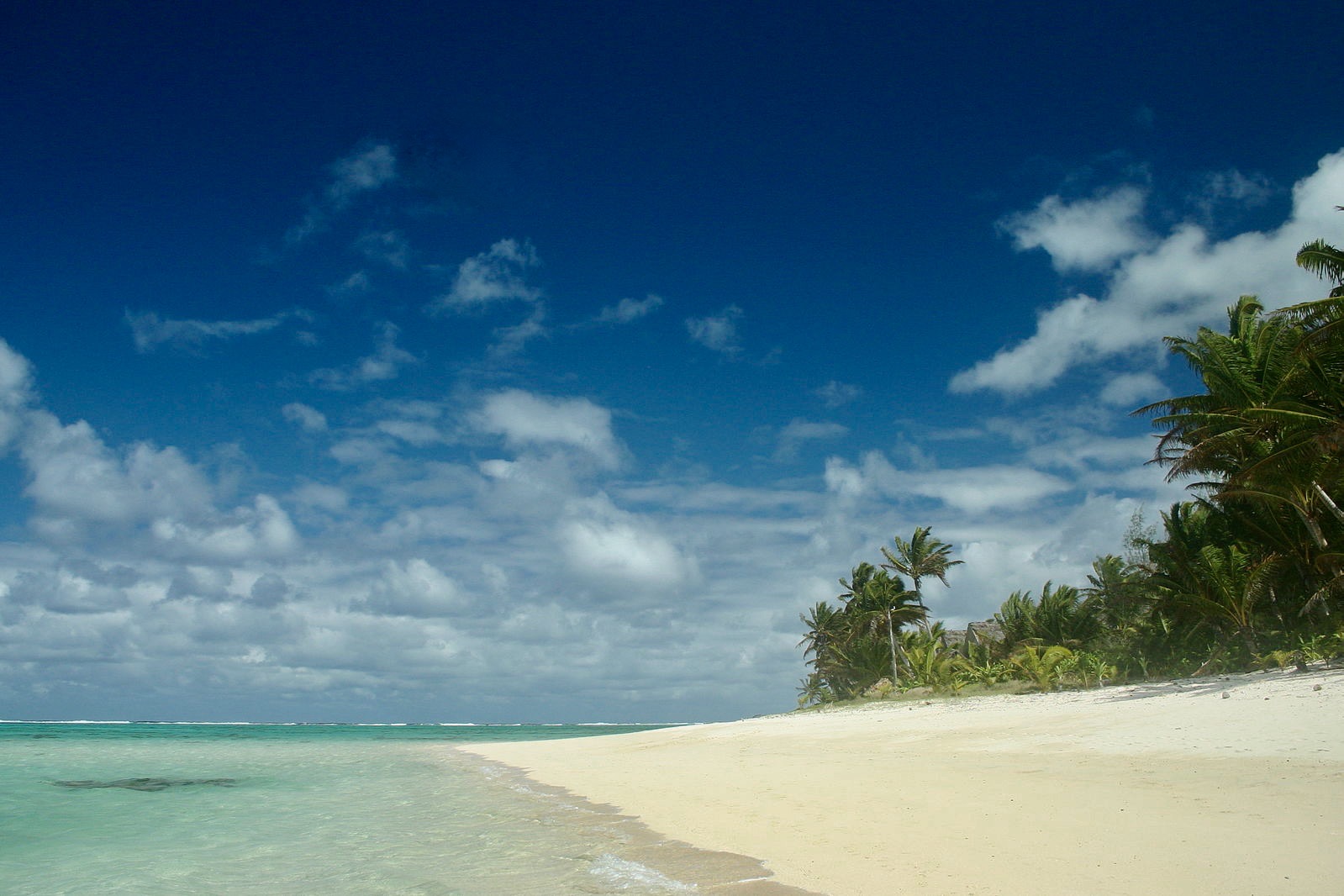
Titikaveka Beach
Titikaveka Beach and lagoon on Rarotonga’s southwest coast is one of the greatest places to swim and snorkel on the island. The water is often so pure that you may see colorful fish just by standing in it. Snorkelers will encounter a plethora of marine life around the many coral heads, and the lagoon is dotted with blue sea stars. It’s also excellent for kayaking. The coral stone Cook Islands Christian Church, built in 1841, may be seen in a neighboring little hamlet.
8-day Itinerary in Cook Islands
Day 1
Arrive in Rarotonga
You will feel more at ease the moment you walk off the plane! As you reach the airport, residents greet you with “Kia Orana” and the tropical music of Jake Numanga’s ukelele. Hello and welcome to the Cook Islands!
If you’re flying directly from Sydney on Air New Zealand, make sure you pre-book an early check-in at your hotel. The flight arrives at 6.25am, and it’ll be a long day if you have to wait until 2pm to check in.

- Backpacker:
- Budget:
- Mid-range:
- Luxury:
When it becomes dark, a foreign city may be twice as dangerous - especially if you don't understand the language and are unfamiliar with the area. There is no reason to be alarmed about walking home alone in the dark as there is little crime recorded in Rarotonga to warrant any bit of worry. But, always take taxis at night and never leave crowded areas to unlit alleys or streets if you don't feel comfortable.
This section will be added shortly. Refer to the transportation block in the top section.
Day 2
Head to Avarua
This morning for a Polynesian breakfast, head into Avarua and visit Punanga Nui Cultural Market, which has a variety of tasty food options. The markets are open from 8 a.m. to 12 p.m., so plan to come first thing in the morning for breakfast or an early lunch!
Grab your snorkeling gear and head out to ‘Fruits of Rarotonga,’ Titikaveka, or the lagoon in front of Aroa beach during the day for the finest underwater viewing experience.
Later in the day, why not take advantage of one of Rarotonga’s stunning sunsets by making an early dinner reservation at Manuia Beach Resort’s OTB Restaurant for a barefoot luxury dining experience?
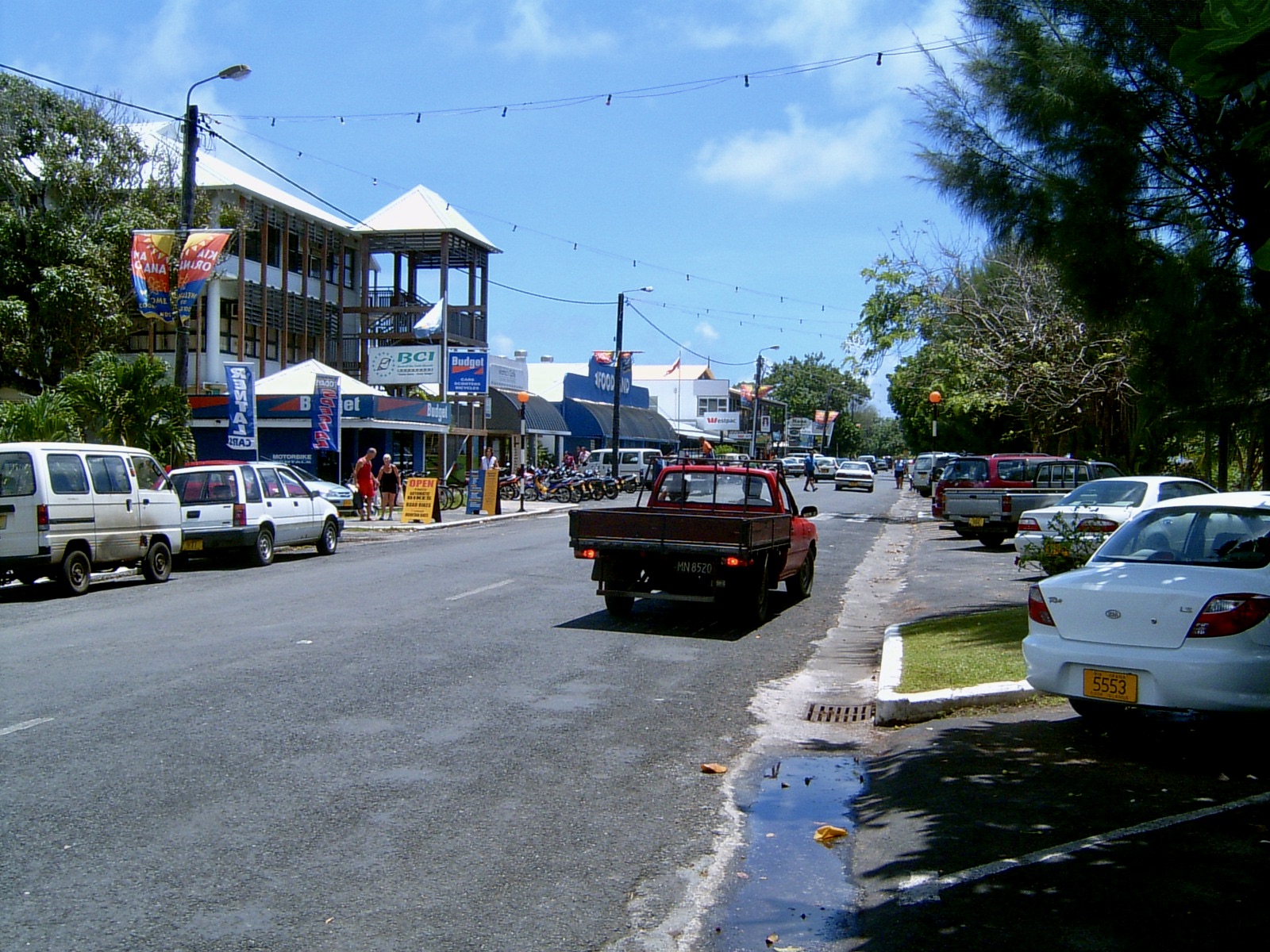
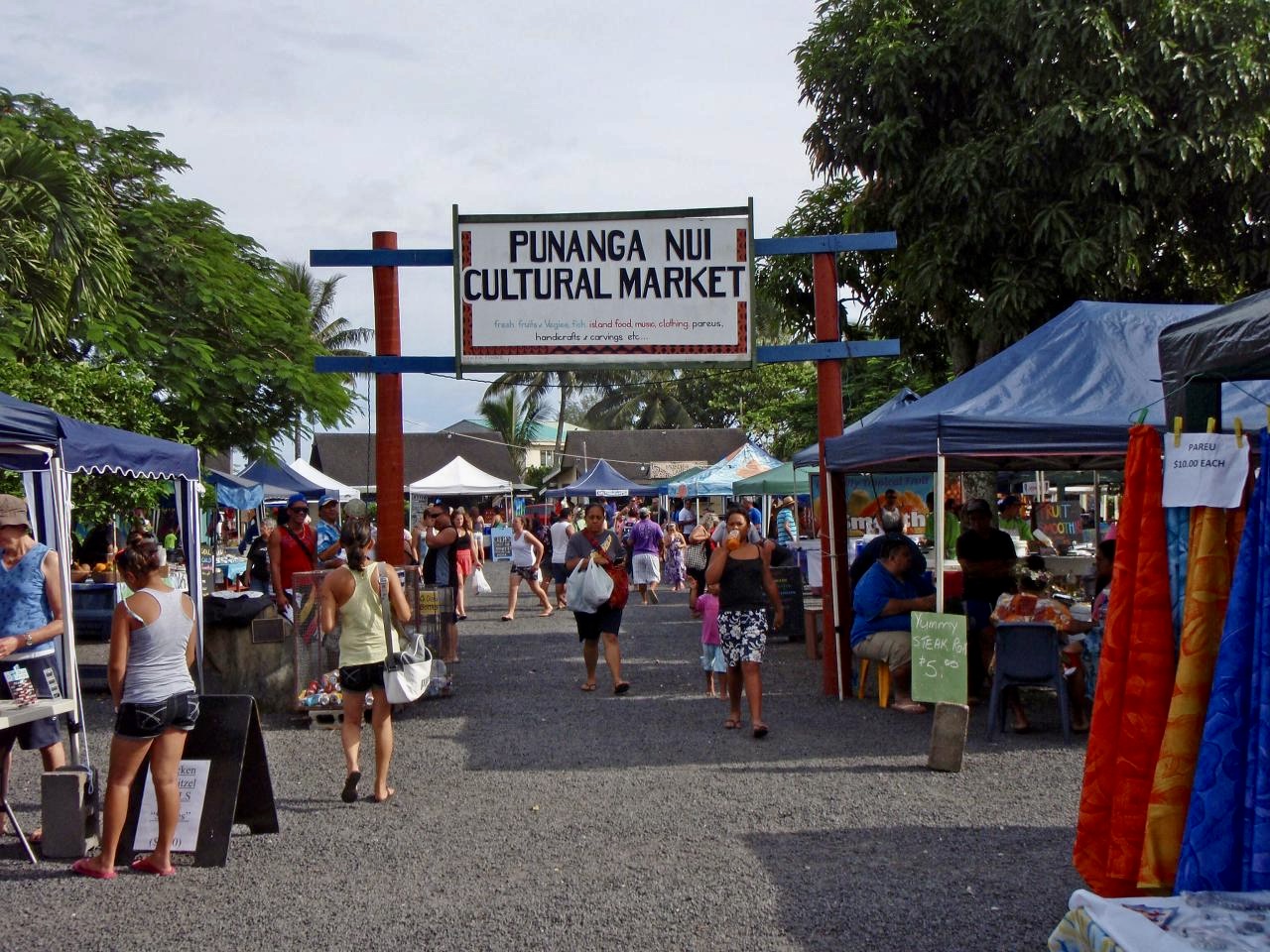
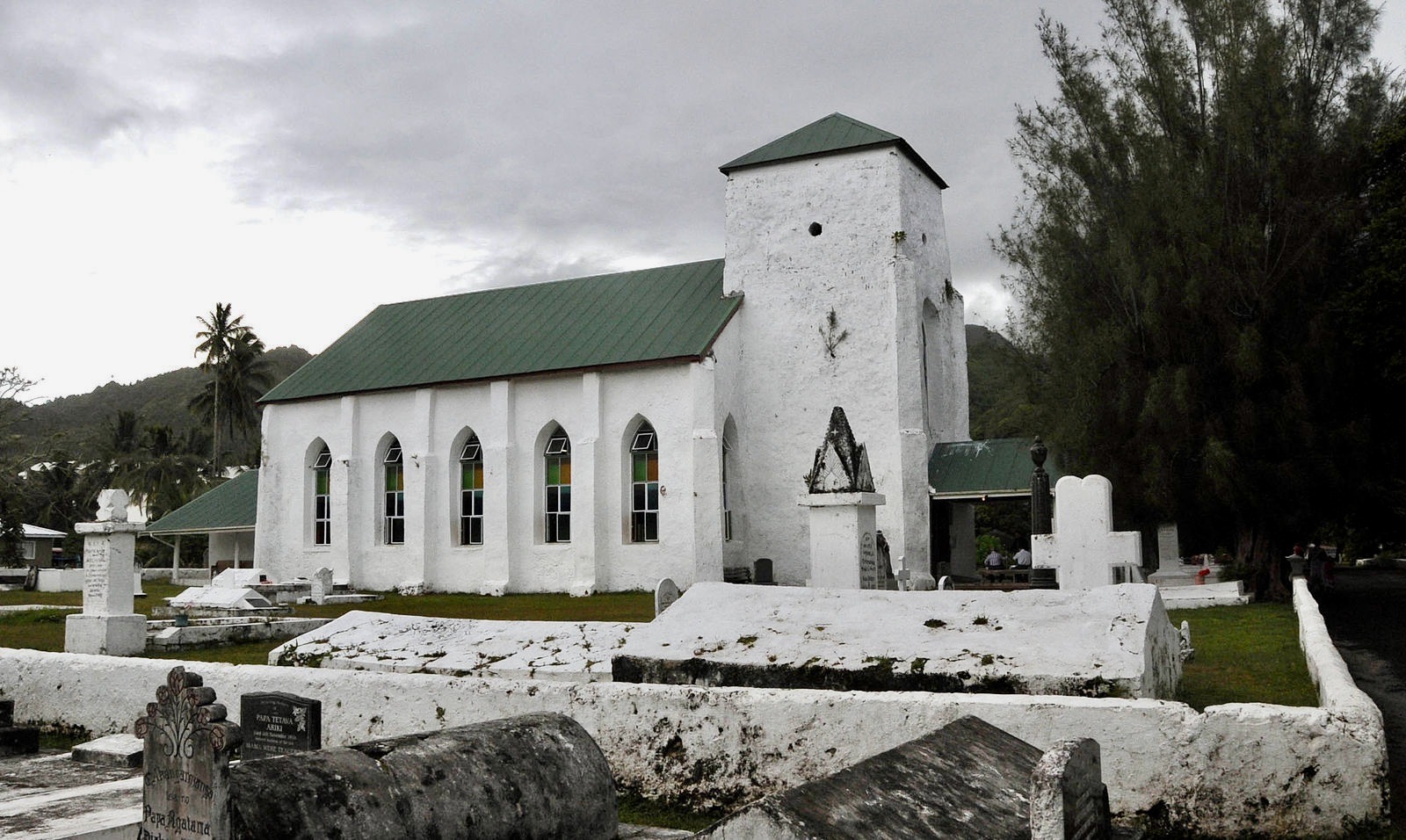
Day 3
Take it Slow
If you haven’t been to a South Pacific church service yet, this is the day! Go to Cook Islands Christian Church in Avaru or head to your nearest church at 10 a.m. on Sundays for a terrific chance to meet the locals and learn about their way of life. Spend the rest of the day relaxing, unwinding, and perhaps seeing another sunset in the evening.
Day 4
Cross Island Trek
After your breakfast and relaxing morning on the beach, crank it up a notch. The ‘cross-island journey,’ which runs from one side of the island to the other, is one of the most popular hikes on the island. Climb through the thick forest for a breathtaking view from the highest peak, Te Rua Manga (The Needle), from where you can virtually see the entire island! After your 3-4 hour hike, cool yourself with a dip at Wigmore’s waterfall. Later, stop by Beluga Café for lunch; we guarantee that once you’ve eaten their amazing food, you’ll be counting down the days until you can return!
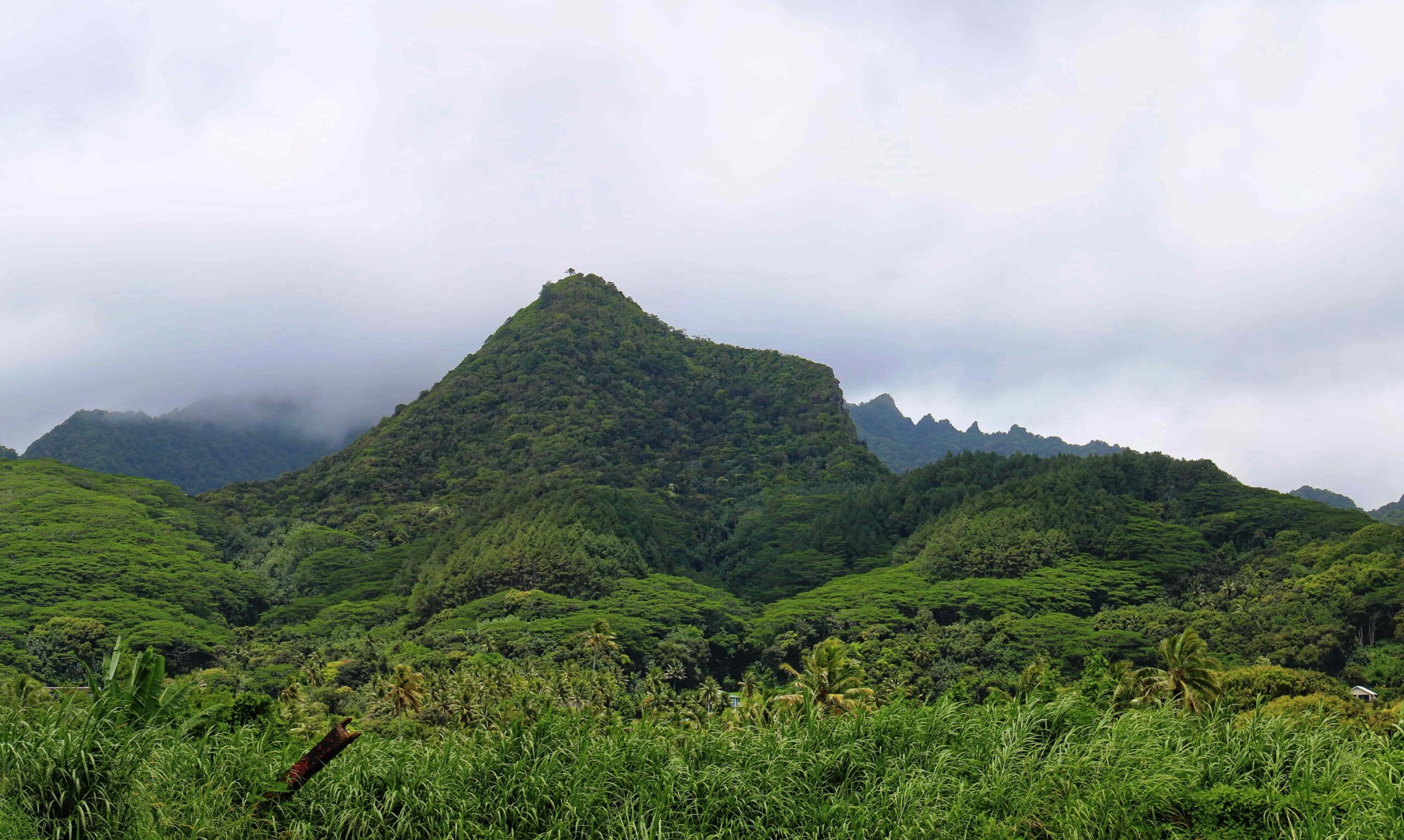



Day 5
Head to Aitutaki
Visit the stunning island of Aitutaki, which is only a 50-minute flight from Rarotonga. The journey begins with a tour of the island, but the true highlight is a sail through the iconic turquoise Aitutaki lagoon. Ride aboard the Titi-ai-Tonga, a traditionally designed catamaran, and the Vaka hosts will offer you a lesson in the area’s history and culture.
Throughout the tour, you will stop for snorkeling, have BBQ lunch, swim with huge trevally, and visit One Foot Island, where your passport will be issued with the ultimate foot-shaped stamp! The trip concludes with a short flight back to Rarotonga, just in time for a well-deserved drink before supper.
Day 6
Lagoon Cruise in Rarotonga
Your day begins at 10 a.m. when you board a Captain Tama’s Lagoon Cruise. Tour Rarotonga’s inner lagoon on a glass-bottom boat, then stop at the marine reserve for some coral gazing and snorkeling before heading to Koromiri Island on Muri Lagoon for a BBQ fish lunch. Try some of the native cuisine for lunch, and then your tour guides will amuse you with coconut husking, tree climbing, and a pareu (sarong) tying display after you eat.
At night, go to Muri Night Market for some kai (food); there are a variety of eating options set up, and it’s the ideal chance to experience a variety of cuisines all in one spot! The market is open seven days a week from 5-8pm, and there is entertainment as you dine.
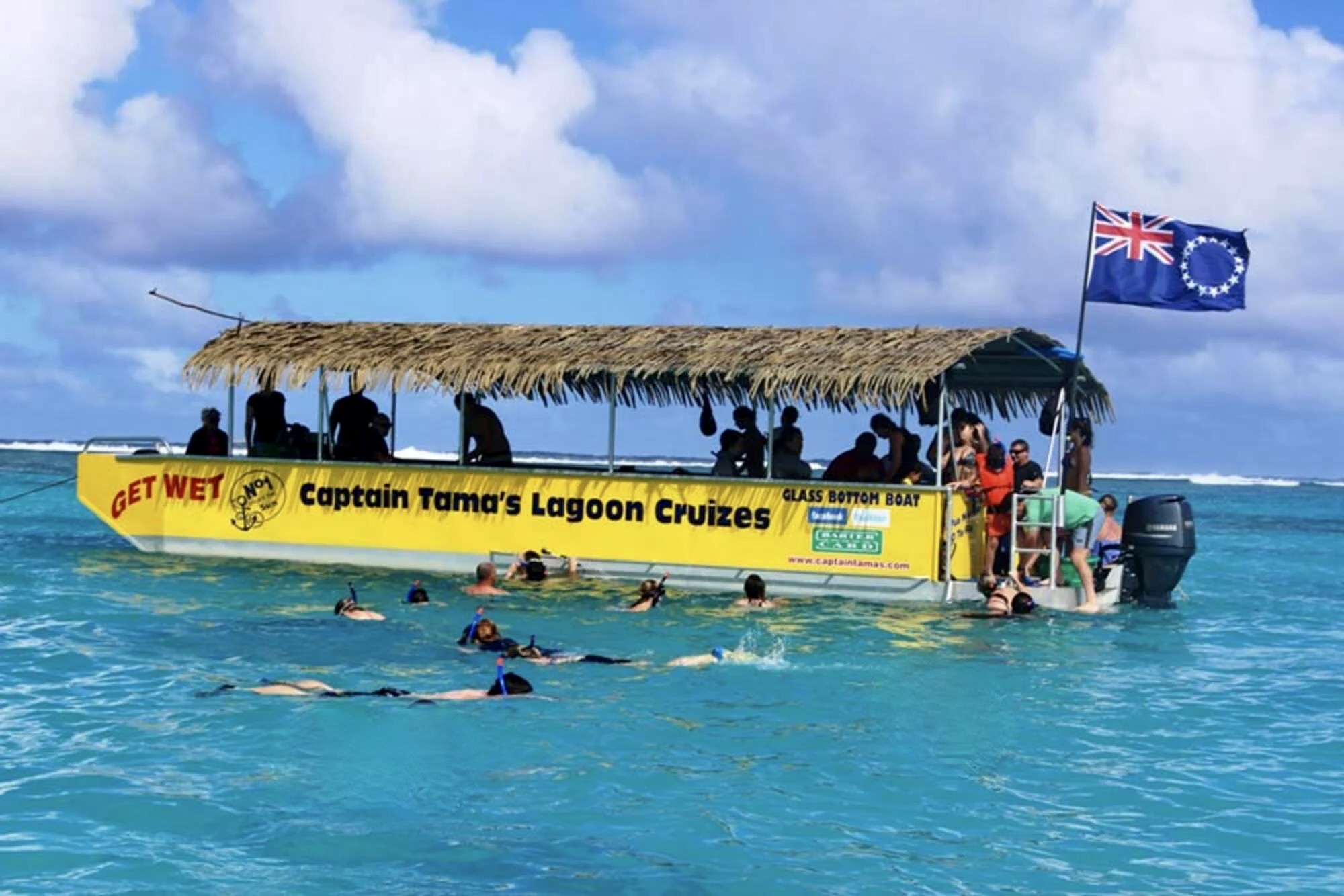



Day 7
Paddle or Kayak?
Pack some snacks, rent a kayak or stand-up paddleboard, and visit one of Muri Lagoon’s Motu (little islets), where you can swim, snorkel, or simply work on your tan while being on your own private island for the day! We recommend Charlie’s Café for lunch when you’ve worked up an appetite. Try the fish sandwiches, which are huge and delicious. If the weather permits, rent a bike and pedal around the island. The drive around Rarotonga is generally level and provides an excellent opportunity to observe the island. Before returning to the hotel, stop at Vaiana’s for a nice drink.
Tonight, try Antipodes, a relatively new restaurant on the island. The crew mastered both service and wonderful food! Make a reservation; they tend to fill up quickly! If you want to go out in the town, the most popular location to dance is Rehab.
Day 8
“Aere Ra” Cook Islands
Today is departure day; if you have an afternoon flight, check out of your lodging and stroll across the street to the Hula Bar at the Islander Hotel. Have a drink or something to eat as you wait for boarding time; it’s the ideal way to cap off an amazing Cook Islands vacation. Aere Ra (Goodbye).

The Most Popular Food in Cook Islands
Polynesian tastes merge with modern culinary influences to make the most of the Cook Islands’ tropical fruit and predominantly seafood riches. Bread or rice is traditionally served with starchy vegetables such as taro, kumara, coconut, fish, and a range of ocean delicacies such as pasua (giant clam). Breadfruit, banana, cassava, coconut, papaya, and taro are all examples of tropical fruits. Fruit and veggies are grown locally.

Ika Mata
The native delicacy Ika Mata is at the top of the list of Cook Islands cuisines to taste. Ika Mata means “raw fish” in Cook Island Maori, but the dish packs a lot more punch. It’s akin to a wonderful Polynesian salad, with a base of coconut cream, finely chopped vegetables, and raw fish, usually Marora (flying fish). When mixed, it creates a delightfully refreshing dessert.

Banana Poke
You can’t go wrong with Banana Poke (pronounced poh – key), which is not only yummy but also filling. This is because it is what Cook Islanders do with their overripe bananas. Cooked with a touch of coconut cream and a unique ingredient of arrowroot, and served with a copious amount of sugar, it will leave you with nothing but a grin.

Rori
Rori, commonly known as Sea Cucumber, is another delicious traditional Polynesian treat to sample. As you may see during your snorkeling excursions, the Cook Islands are abundant in them, which is why the inhabitants have developed a meal from it. It takes some ability to prepare and cook Rori properly, but when done correctly, it has a superb salty sweet flavor. Frequently prepared with garlic, butter, and herbs.

Curried Eke
Curried Eke is another excellent Cook Island meal that features octopus. This recipe’s components are really simple, but they work so wonderfully together. The cooked octopus is recooked in coconut cream and onions with aromatic spices, garlic, and pepper to taste. That’s all there is to it, but it tastes amazing!
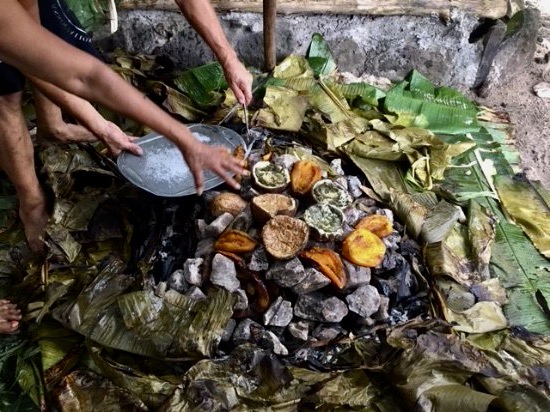
Umukai
Last but not least, an Umukai, a Pacific Island Polynesian Feast fit for royalty, is a must-try when it comes to Cook Island cuisine. Food for an Umukai is cooked in a “Umu” (underground oven) similar to the New Zealand Hangi, which is filled with fuel and hot stones upon which the food wrapped in banana leaves is placed. The end product is a wonderful dinner of exquisite meats and delicious veggies that will fill your belly with goodness.
What's the Travel Budget for Cook Islands?
Flights
- Flights start at roughly $155 from nearby countries. Tickets however on average cost around $500 and can cost way more depending on which class and from which country you depart from.
Accommodation
- Nomad Backpacking style travelers can expect to spend around $250 for a week
- Budget travelers can expect to spend around $390 for a week
- Mid-range travelers can expect to spend around $650 for a week
- Luxury travelers can expect to spend around $1,150 for a week
Food Budget (Three meals and drinks)
- Nomad Backpacking style travelers can expect to spend around $15 per person per day
- Budget travelers can expect to pay around $25 per person per day
- Mid-range travelers on average would cost $30 to $40 per person per day
- Luxury travelers can expect to pay around $50 to $80 per person per day
Overall Budget Styles (Not including Flights, Tours, Transportation, or Car Rental)
- Nomad Backpacking style travelers can expect to spend roughly $250 for a week
- Budget travelers can expect to spend close to $420 for one person for a week
- Mid-range travelers can expect to spend approximately $710 for one person for a week
- Luxury travelers can expect to spend around $1,750 for one person for a week
Flights
- Flights start at roughly $155 from nearby countries. Tickets however on average cost around $500 and can cost way more depending on which class and from which country you depart from.
Accommodation
- Nomad Backpacking style travelers can expect to spend around $250 for a week
- Budget travelers can expect to spend around $390 for a week
- Mid-range travelers can expect to spend around $650 for a week
- Luxury travelers can expect to spend around $1,150 for a week
Food Budget (Three meals and drinks)
- Nomad Backpacking style travelers can expect to spend around $15 per person per day
- Budget travelers can expect to pay around $25 per person per day
- Mid-range travelers on average would cost $30 to $40 per person per day
- Luxury travelers can expect to pay around $50 to $80 per person per day
Overall Budget Styles (Not including Flights, Tours, Transportation, or Car Rental)
- Nomad Backpacking style travelers can expect to spend roughly $250 for a week
- Budget travelers can expect to spend close to $420 for one person for a week
- Mid-range travelers can expect to spend approximately $710 for one person for a week
- Luxury travelers can expect to spend around $1,750 for one person for a week
Flights
- Flights start at roughly $155 from nearby countries. Tickets however on average cost around $500 and can cost way more depending on which class and from which country you depart from.
Accommodation
- Nomad Backpacking style travelers can expect to spend around $250 for a week
- Budget travelers can expect to spend around $390 for a week
- Mid-range travelers can expect to spend around $650 for a week
- Luxury travelers can expect to spend around $1,150 for a week
Food Budget (Three meals and drinks)
- Nomad Backpacking style travelers can expect to spend around $15 per person per day
- Budget travelers can expect to pay around $25 per person per day
- Mid-range travelers on average would cost $30 to $40 per person per day
- Luxury travelers can expect to pay around $50 to $80 per person per day
Overall Budget Styles (Not including Flights, Tours, Transportation, or Car Rental)
- Nomad Backpacking style travelers can expect to spend roughly $250 for a week
- Budget travelers can expect to spend close to $420 for one person for a week
- Mid-range travelers can expect to spend approximately $710 for one person for a week
- Luxury travelers can expect to spend around $1,750 for one person for a week
Flights
- Flights start at roughly $155 from nearby countries. Tickets however on average cost around $500 and can cost way more depending on which class and from which country you depart from.
Accommodation
- Nomad Backpacking style travelers can expect to spend around $250 for a week
- Budget travelers can expect to spend around $390 for a week
- Mid-range travelers can expect to spend around $650 for a week
- Luxury travelers can expect to spend around $1,150 for a week
Food Budget (Three meals and drinks)
- Nomad Backpacking style travelers can expect to spend around $15 per person per day
- Budget travelers can expect to pay around $25 per person per day
- Mid-range travelers on average would cost $30 to $40 per person per day
- Luxury travelers can expect to pay around $50 to $80 per person per day
Overall Budget Styles (Not including Flights, Tours, Transportation, or Car Rental)
- Nomad Backpacking style travelers can expect to spend roughly $250 for a week
- Budget travelers can expect to spend close to $420 for one person for a week
- Mid-range travelers can expect to spend approximately $710 for one person for a week
- Luxury travelers can expect to spend around $1,750 for one person for a week
If you want to know what to pack, read this list below:
- This is a casual tropical country, dress accordingly
- Raincoat or Light Waterproof Jacket
- Hiking Boots or Sturdy Sneakers (Shoes You Don’t Mind Getting Wet)
- Sunscreen
- Insect Protection – Repellent and Clothing
- Sunglasses and Sun Hat
- Water Shoes
- Beach Towels/Sarong
- Dry Bag
- Money Belt or Cross Bag
- Portable Medical Kit
- Flashlight or Headlamp
- Copies of your passport.
- Get all the needed vaccinations before traveling
- A power bank is a must in any travel.
- Always have some cash with you just in case there are no ATMs and if you are dealing with a business that solely accepts cash
- Get yourself an adapter for your gadgets
- 1 toothbrush
- 1 tube of toothpaste
- 1 razor
- 1 package of dental floss
- 1 small bottle of shampoo
- 1 small bottle of shower gel
- 1 towel
- Deodorant
- Band-Aids
- Hydrocortisone cream
- Antibacterial cream
- Earplugs
- Tylenol
- Hand sanitizer (germs = sick = bad holiday)
- A key or combination lock
- Zip-lock bags
- Plastic bags (great for laundry)
- Universal charger/adaptor
- LifeStraw (A water bottle with a purifier)
- 1 dry shampoo spray & talc powder
- 1 hairbrush
- Makeup you use
- Hairbands & hair clips
- Feminine hygiene products
Clothing For Boys
- 1 pair of jeans or khaki pants
- 1 pair of shorts
- 1 bathing suit
- 5 T-shirts
- 1 long-sleeved T-shirt
- 1 pair of flip-flops
- 1 pair of sneakers
- 6 pairs of socks
- 5 pairs of boxer shorts
Clothing For Girls
- 1 swimsuit
- 1 sarong
- 1 pair of stretchy jeans
- 1 pair of leggings
- 2-3 long-sleeve tops
- 2-3 T-shirts
- 3-4 spaghetti tops
- 1 light cardigan
Want to plan your own trip, here are some of the best resources that can help you
- Skyscanner – They search small websites and budget airlines that larger search sites tend to miss. They are hands down the number one place to start.
- Momondo – This is another favorite flight search engine because they search such a wide variety of sites and airlines. Always check here too.
- Booking.com – The best all-around booking site that constantly provides the most affordable and lowest rates. They have the widest selection of budget accommodation.
- Couchsurfing – This website allows you to stay on people’s couches or spare rooms for free. It’s a great way to save money while meeting locals who can tell you the ins and outs of their city. The site also lists events you can attend to meet people (even if you’re not staying with someone).
- Intrepid Travel – If you want to do group tours, go with Intrepid. They offer good small group tours that use local operators and leave a small environmental footprint.
- Grassroots Volunteering – For volunteering, Grassroots Volunteering compiles a list of good local volunteer organizations that keep the money within the community.
- Get Your Guide – Get Your Guide is a huge online marketplace for tours and excursions. They have tons of tour options available in cities all around the world, including everything from cooking classes, walking tours, street art lessons, and more! It has the world’s largest collection of things to do with more than 30,000 activities in 7500 destinations.
- SafetyWing – Safety Wing offers convenient and affordable plans tailored to digital nomads and long-term travelers. They have cheap monthly plans, great customer service, and an easy-to-use claims process that makes it perfect for those on the road.
- Trip Advisor: Check the reviews and then book your accommodation. TripAdvisor is where you go when you want to compare prices with multiple accommodation providers.
- VRBO: is the main search engine to use when you are looking for a home or apartment rental. It can sometimes be cheaper than hotels and it is the best way to stay in areas that offer a more local feel.
- Hostelworld: With one of the largest databases of hostels in the world, Hostelworld is the go-to site when you are looking for budget accommodation.
- Rome 2 Rio: If you want to see how to get somewhere by plane, train, bus, ferry, or car Rome2Rio lays it all out for you as well as related costs.
- World Nomads Insurance: When traveling you should always have travel insurance. We have found the best bang for your buck is by far World Nomads.
Final Thoughts on Cook Islands
Cook Islands has a sophisticated and rich heritage that can be seen across the nation dating back to 1,000 AD, with its colonial constructions and kikau’s which are traditional buildings, spectacular and distinct landmarks, amazing hospitality, thrilling songs and dances, and a breathtaking picture perfect environment. A terrific choice for anybody looking for a perfect place to visit in Oceania. Cook Islands is stunningly gorgeous, with magnificent national treasures, fauna, and breathtaking landscape. Would you travel to Cook Islands?
Have you ever visited Cook Islands? Please leave your opinions in the space below.